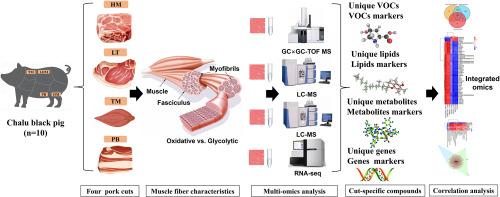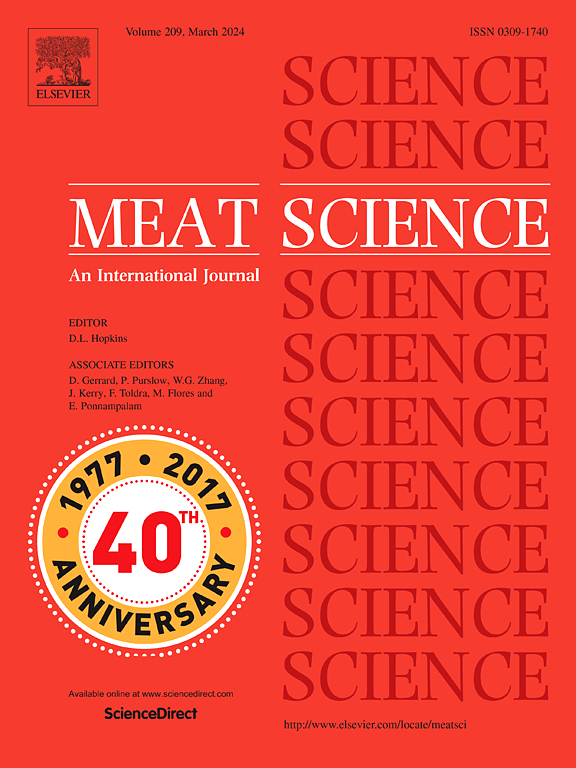Flavor characterization of pork cuts in Chalu black pigs using multi-omics analysis
IF 7.1
1区 农林科学
Q1 Agricultural and Biological Sciences
引用次数: 0
Abstract
The study investigated the flavor variations in four different fresh pork cuts (longissimus thoracis, LT; trapezius muscle, TM; hamstring muscle, HM; Pork Belly, PB) from Chalu black pigs (ten castrated boars) using multi-omics techniques. The research also explored the influence of muscle fiber type on the flavor profiles of these cuts. Results from quantitative real-time PCR (qRT-PCR) indicated significant differences in muscle fiber type across the four pork cuts in various anatomical locations. Each cut exhibited distinctive volatile organic compounds (VOCs) profiles, with HM displaying a sweet and fruity green flavor, LT showcasing a fatty and nutty taste, PB presenting a fresh, citrusy, and green flavor, and TM offering a floral and bitter note. Variations in fatty acid carbon number and saturation were observed among the cuts, with HM, LT, and PB being rich in fatty acids with C16–18, C19–21, and 3 double bonds, respectively. The metabolites specific to each cut were found to play key roles in different metabolic pathways, such as protein-related pathways for HM, arginine biosynthesis for LT, lysine biosynthesis for PB, and D-arginine and D-ornithine metabolism for TM. Differentially expressed genes (DEGs) were associated with amino acid metabolism for HM, glycolysis/gluconeogenesis for LT, and cellular aromatic compound organization for PB. Notably, HM and PB displayed unique flavor characteristics, while TM exhibited relatively neutral features. The study also identified correlations among VOCs, muscle fiber type, lipids, metabolites, and gene patterns specific to each cut, highlighting the complex interplay of factors influencing pork flavor.

利用多组学分析确定茶陵黑猪猪肉风味特征
该研究利用多组学技术调查了四种不同新鲜猪肉(胸长肌,LT;斜方肌,TM;腿筋肌,HM;猪肚,PB)的风味变化,这些猪肉来自 Chalu 黑猪(10 头阉公猪)。研究还探讨了肌肉纤维类型对这些肉类风味的影响。定量实时 PCR (qRT-PCR) 的结果表明,四种猪肉不同解剖位置的肌肉纤维类型存在显著差异。每种猪肉都呈现出独特的挥发性有机化合物(VOCs)特征,其中 HM 表现出甜美的绿色果味,LT 表现出脂肪和坚果味,PB 表现出新鲜、柑橘和绿色风味,而 TM 则表现出花香和苦味。不同切片的脂肪酸碳数和饱和度存在差异,HM、LT 和 PB 分别富含 C16-18、C19-21 和 3 个双键的脂肪酸。研究发现,各切口特有的代谢物在不同的代谢途径中发挥着关键作用,如 HM 的蛋白质相关途径、LT 的精氨酸生物合成、PB 的赖氨酸生物合成以及 TM 的 D-精氨酸和 D-鸟氨酸代谢。差异表达基因(DEGs)与 HM 的氨基酸代谢、LT 的糖酵解/葡萄糖生成和 PB 的细胞芳香化合物组织有关。值得注意的是,HM 和 PB 表现出独特的风味特征,而 TM 则表现出相对中性的特征。该研究还确定了挥发性有机化合物、肌肉纤维类型、脂类、代谢物和基因模式之间的相关性,这些因素对猪肉风味的影响错综复杂。
本文章由计算机程序翻译,如有差异,请以英文原文为准。
求助全文
约1分钟内获得全文
求助全文
来源期刊

Meat Science
工程技术-食品科技
CiteScore
12.60
自引率
9.90%
发文量
282
审稿时长
60 days
期刊介绍:
The aim of Meat Science is to serve as a suitable platform for the dissemination of interdisciplinary and international knowledge on all factors influencing the properties of meat. While the journal primarily focuses on the flesh of mammals, contributions related to poultry will be considered if they enhance the overall understanding of the relationship between muscle nature and meat quality post mortem. Additionally, papers on large birds (e.g., emus, ostriches) as well as wild-captured mammals and crocodiles will be welcomed.
 求助内容:
求助内容: 应助结果提醒方式:
应助结果提醒方式:


